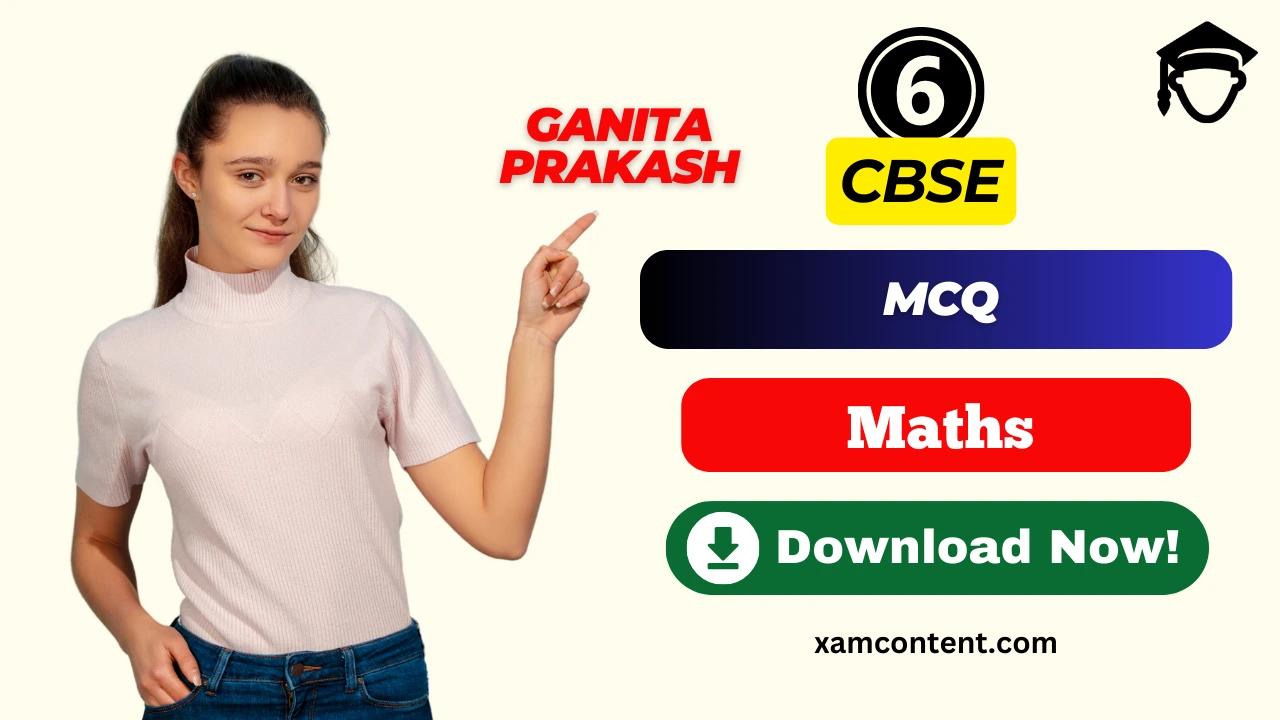Last Updated on November 4, 2025 by XAM CONTENT
Understanding the key concepts of Class 6 Maths Chapter 8 – Playing with Constructions is crucial for exam success. To make your revision easier, we have created chapterwise mcq questions with Answers for class 6 Maths based on the latest syllabus and exam pattern. It is a part of MCQ Questions for CBSE Class 6 Maths Series.
These multiple-choice questions will help you assess your knowledge, improve accuracy, and boost confidence for your exams. Whether you are preparing for school tests, online tests or competitive exams, these Playing with Constructions MCQs will strengthen your conceptual clarity.
| Chapter | Playing with Constructions |
| Book | Ganita Prakash |
| Type of Questions | MCQ Questions |
| Nature of Questions | Competency Based Questions |
| Board | CBSE |
| Class | 6 |
| Subject | Maths |
| Useful for | Class 6 Studying Students |
| Answers provided | Yes |
| Difficulty level | Mentioned |
| Important Link | Class 6 Maths Chapterwise MCQ Questions |
MCQ Questions on Playing with Constructions Class 6 Maths (PDF Download)
Q1. All points on a circle are at the same distance from its ________.
(a) diameter
(b) centre
(c) chord
(d) tangent
Show Answer
Ans: (b) centre.
Explanation: A circle is the set of all points equidistant from a fixed point called the centre.
Q2. The fixed distance from the centre to any point on the circle is called the ________.
(a) diameter
(b) radius
(c) arc
(d) sector
Show Answer
Ans: (b) radius.
Explanation: Radius is the distance from centre to the circle’s boundary; diameter = 2 × radius.
Q3. To draw a circle of radius 4 cm using instruments, you should set the compass opening by measuring 4 cm on the ________.
(a) protractor
(b) ruler/scale
(c) set square
(d) divider
Show Answer
Ans: (b) ruler/scale.
Explanation: Open the compass against the ruler until the pencil–tip distance is 4 cm, then rotate with the tip fixed.
Q4. In a rectangle, the opposite sides are equal and ________.
(a) adjacent sides are equal
(b) all angles are 60°
(c) all angles are 90°
(d) diagonals are perpendicular
Show Answer
Ans: (c) all angles are 90°.
Explanation: A rectangle has equal opposite sides and four right angles.
Q5. In a square, which of the following is always true?
(a) Only opposite sides are equal
(b) All sides are equal and all angles are 90°
(c) Only adjacent sides are equal
(d) Angles are not equal
Show Answer
Ans: (b).
Explanation: A square satisfies both “all sides equal” and “all angles 90°.”
Q6. A square is rotated by some angle about its centre. The rotated figure is:
(a) not a square
(b) a rectangle but not a square
(c) still a square
(d) a rhombus
Show Answer
Ans: (c) still a square.
Explanation: Rotation doesn’t change side lengths or angles; properties stay the same.
Q7. Which name is not valid for a square with vertices in order P–Q–R–S?
(a) PQRS
(b) QRSP
(c) PRQS
(d) RSPQ
Show Answer
Ans: (c) PRQS.
Explanation: A valid name follows consecutive travel around the boundary; PRQS skips order.
Q8. To construct a square PQRS of side 6 cm, after drawing PQ = 6 cm, the next essential step is to draw a line through P that is ________ to PQ.
(a) parallel
(b) equal
(c) bisecting
(d) perpendicular
Show Answer
Ans: (d) perpendicular.
Explanation: Adjacent sides of a square are equal and meet at 90°.
Q9. To construct a rectangle with sides 4 cm and 6 cm, you must ensure:
(a) opposite sides equal and all angles 90°
(b) all sides 6 cm
(c) diagonals equal to sides
(d) angles 60°
Show Answer
Ans: (a).
Explanation: These are the defining properties of rectangles used during construction checks.
Q10. To locate a point B that is 7 cm from D and lies on a given line l, an efficient method is to draw:
(a) a random arc anywhere
(b) a circle/arc of radius 7 cm centred at D and find its intersection with l
(c) a perpendicular bisector of an unknown segment
(d) a 60° ray
Show Answer
Ans: (b).
Explanation: Intersect the line with a circle (or arc) of radius 7 cm centred at D to pinpoint B without trial-and-error.
Q11. In a rectangle PQRS, the line segments PR and QS are called ________.
(a) medians
(b) bisectors
(c) diagonals
(d) heights
Show Answer
Ans: (c) diagonals.
Explanation: A diagonal connects opposite vertices of a polygon.
Q12. For a rectangle, which of the following is true about its two diagonals?
(a) They are always unequal
(b) They are equal in length
(c) They are perpendicular
(d) They are equal only if it is a square
Show Answer
Ans: (b).
Explanation: Rectangles have equal diagonals; in squares, they are equal and also meet at right angles.
Q13. A diagonal of a rectangle divides a right angle into two parts. Which statement is correct in general?
(a) The two parts are always equal
(b) The two parts can vary depending on the rectangle’s side lengths
(c) The two parts are 60° and 30° only
(d) They are never equal
Show Answer
Ans: (b).
Explanation: The split depends on the rectangle’s proportions; in a square they become equal (45°–45°).
Q14. To construct a rectangle when one side (5 cm) and one diagonal (7 cm) are given, a key planning step is to:
(a) guess the other side by trial
(b) draw the base, then a perpendicular line at an endpoint, and mark the diagonal length via a circle/arc
(c) draw two equal sides at 60°
(d) start with the diagonal as a side
Show Answer
Ans: (b).
Explanation: Draw base DC = 5 cm; erect a perpendicular at C; intersect it with an arc of radius 7 cm centred at D to get B.
Q15. The set of all points that are exactly 5 cm from a point B forms:
(a) a line segment
(b) a circle of radius 5 cm centred at B
(c) a rectangle
(d) a square
Show Answer
Ans: (b).
Explanation: Locus of points equidistant from a fixed point is a circle.
Q16. To locate a point A that is 5 cm from both B and C (forming an isosceles “roof”), you should draw:
(a) arcs of radius 5 cm with centres at B and C and take their intersection
(b) a 5 cm line from B only
(c) a perpendicular bisector of BC only
(d) an angle bisector at B
Show Answer
Ans: (a).
Explanation: Intersecting arcs of equal radius from B and C give all points equidistant from both; intersection gives A.
Q17. Which statement is true about constructing a rectangle that can be split into two identical squares?
(a) The long side is twice the short side
(b) Both sides are equal
(c) The longer side equals two times the shorter side
(d) The rectangle cannot be split into squares
Show Answer
Ans: (c).
Explanation: Each square side equals the short side; long side = 2 × short side.
Q18. To draw a perpendicular bisector of a line segment, arcs are drawn with radius ________.
(a) less than half the segment
(b) equal to half the segment
(c) greater than half the segment
(d) double the segment
Show Answer
Ans: (c).
Explanation: Radius must be more than half the segment for arcs to intersect.
Q19. Which of the following instruments is most useful to draw an angle of 90°?
(a) Compass
(b) Protractor
(c) Divider
(d) Ruler only
Show Answer
Ans: (b).
Explanation: A protractor directly measures and helps construct right angles accurately.
Q20. The intersection point of angle bisectors of a triangle is called its ________.
(a) circumcentre
(b) orthocentre
(c) centroid
(d) incentre
Show Answer
Ans: (d) incentre.
Explanation: Angle bisectors meet at incentre — centre of the inscribed circle.
We hope the given mcq questions with Answers for Playing with Constructions Class 6 helps you in your learning.

Also check
- The Other Side of Zero – Class 6 Maths Chapter 10 MCQ Questions with Answers | Ganita Prakash Book
- Symmetry – Class 6 Maths Chapter 9 MCQ Questions with Answers | Ganita Prakash Book
- Playing with Constructions – Class 6 Maths Chapter 8 MCQ Questions with Answers | Ganita Prakash Book
- Fractions – Class 6 Maths Chapter 7 MCQ Questions with Answers | Ganita Prakash Book
- Perimeter and Area – Class 6 Maths Chapter 6 MCQ Questions with Answers | Ganita Prakash Book
- Prime Time – Class 6 Maths Chapter 5 MCQ Questions with Answers | Ganita Prakash Book
- Data Handling and Presentation – Class 6 Maths Chapter 4 MCQ Questions with Answers | Ganita Prakash Book
- Number Play – Class 6 Maths Chapter 3 MCQ Questions with Answers | Ganita Prakash Book
- Lines and Angles – Class 6 Maths Chapter 2 MCQ Questions with Answers | Ganita Prakash Book
- Patterns in Mathematics – Class 6 Maths Chapter 1 MCQ Questions with Answers | Ganita Prakash Book
🚀 Boost Your Exam Prep: Get MCQ Questions for all subjects (Class 6-12) now!
👉 Explore more resources on CBSE Class 6
Topics from which mcq questions may be asked
- Drawing basic shapes
- Using ruler and compass
- Constructing angles
Constructions are about precision and creating perfect shapes.

You may also like

Frequently Asked Questions (FAQs) on Playing with Constructions MCQ Questions
Q1: Why should I practice Class 6 Maths Chapter 8 MCQs?
A1: Practicing MCQs helps in quick revision, improves problem-solving speed, and enhances conceptual understanding of important topics in Class 6 Maths.
Q2: Are these Class 6 Maths MCQs based on the latest syllabus?
A2: Yes, all the MCQs are designed as per the latest CBSE syllabus and exam pattern to help students prepare effectively.
Q3: Where can I find more MCQs for Class 6 Maths?
A3: You can find more chapter-wise MCQs on our website. These are designed to cover important concepts and prepare you for exams.
Q4: Are the answers provided for all MCQs?
A4: Yes, each MCQ is accompanied by the correct answer and explanations to help students understand and learn better.
Q5: How can I improve my performance in Class 6 Maths MCQs?
A5: To improve your performance, practice regularly, revise key concepts, and take mock tests to assess your knowledge.
Q6: Do these MCQs help in school exams?
A6: Yes, these MCQs are aligned with school exam patterns and help in scoring well by strengthening conceptual clarity.
Q7: Can I download these MCQs for offline practice?
A7: Yes, you can download or print these MCQs for convenient offline practice.



